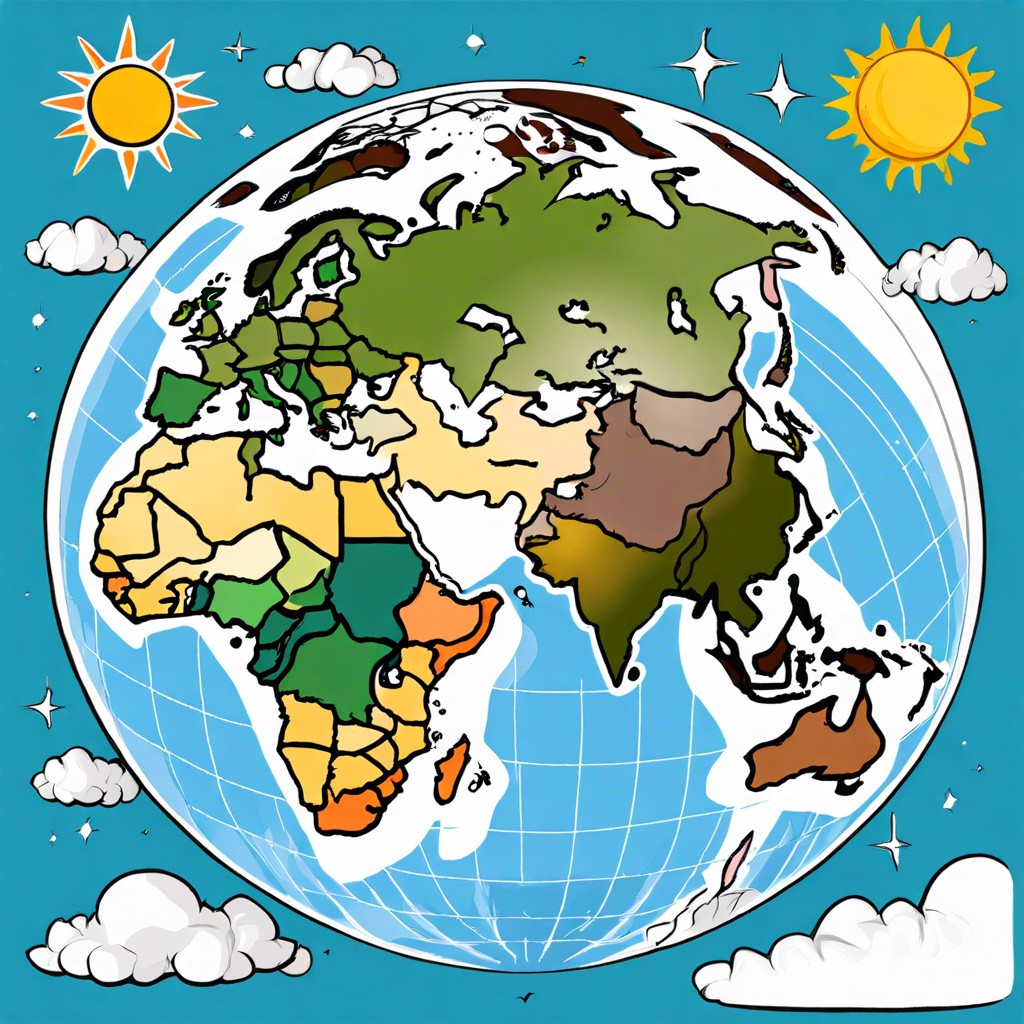You’ll discover what our world might look like and how life could be different if Pangea never split into separate continents.
Imagine a world where your weekend road trips could land you in any current continent without a flight. What if Pangea, the supercontinent, never splintered into the landmasses we roam today? Dive in as we explore the weather changes, oceanic shake-ups, evolutionary quirks, shifts in human history, plus the ground-rumbling activities of a unified land. Get ready for a rollercoaster through time and tectonic tales!
Key takeaways:
- Climate extremes on one massive continent
- Ocean currents chaotic, marine life disrupted
- Unique animal and plant hybridizations
- Migration, cultures mixed on a united landmass
- Geological chaos with intense seismic activity
Continental Climate Impact

So, imagine living on a supercontinent. It would feel like having one colossal backyard. But this mega-land mass would seriously shake up the climate.
Think about it. With fewer coastlines, inland areas would face extreme temperatures. Summers might sizzle hotter than a pizza oven, while winters could be colder than your ex’s heart. Variations in temperature would be as wild as a reality TV show.
Fewer coastlines would also mean less moisture circulating. Cue more dry, arid regions. Deserts as expansive as your pile of laundry? Absolutely.
Ocean currents would be interrupted, affecting global weather patterns. Coastlines would see less rain, adding to their aridness.
The party doesn’t stop there. Pangea would create vast monsoon regions, leading to longer and more intense rainy seasons in some areas.
Impact On Ocean Currents and Marine Life
Ocean currents would resemble a toddler’s drawing—confused and chaotic. Picture a world where the Atlantic Ocean doesn’t even exist and the Pacific is just a massive bathtub. With all the land clumped together, current patterns would be wackier than a carnival funhouse mirror.
Warm water from the tropics would struggle to circulate properly towards the poles, making climate zones as erratic as your Uncle Bob’s dance moves at weddings. Marine life would also pay the price. Many species thrive on existing currents to guide their feeding and migration.
Tuna? Lost. Whales? Running late to the krill buffet. Coral reefs could become the travel bloggers of the ocean: stranded, confused, and possibly extinct. Fisheries? Oh boy, they’d be packing up their rods and moving inland, leaving your fish-and-chips dreams floundering.
Evolutionary Differences in Animal and Plant Life
Imagine a world where kangaroos and llamas could be next-door neighbors. Keeping Pangea intact would have mingled continental species in wild, new ways. Tigers might have strolled through the same forests where jaguars roamed.
The huge supercontinent would have sparked unique evolutionary adaptations. With fewer barriers, crossbreeding between species might have been common, resulting in fascinating hybrids.
Plants would follow a similar trajectory. Imagine a single mega-forest spanning from modern-day Brazil to Nigeria.
Islands, the evolutionary theaters where bizarre species like the dodo emerged, would have been rare. No islands, no isolated species evolving quirky traits like Gigantism or Dwarfism.
In short, without the great continental breakup, biodiversity as we know it would be a wildly different beast—or plant.
Human Migration and Cultural Development
Imagine a world where your neighbor could be from any corner of the massive, united landmass of Pangea. Human migration would have played out like an epic reality show.
Travel and trade would’ve been a breeze, as everything would have been accessible by foot or simple transport methods. No seasickness required. Cultures wouldn’t have had oceans between them, allowing for an even wilder melting pot of traditions, languages, and foods. Forget regional cuisine; you’d have global fusion on every plate.
Wars and conflicts might look vastly different. No major oceans acting as natural barriers. Nations could expand and clash with ease, making Game of Thrones look like a tea party.
Population density would have shifted. Mega-cities might have dotted the landscape, while some regions would remain as wild as your craziest daydream.
Think about historical landmarks! No separate continents means fewer “undiscovered” regions. By now, every nook and cranny would be brimming with human footprints.
And don’t even get started on sporting events. One unified world could turn the Olympics into an everyday street game.
In short, human migration and cultural development would be a supercharged version of reality, where history’s flow would be nothing short of a raging river.
Geological and Seismic Activity
Imagine living on a giant, singular landmass. Earthquakes would be the drama queens here, without performances across multiple stages. They’d all happen on one enormous playground. Knowing our fun-loving planet, this giant hunk of land would still experience plate tectonics like a geological soap opera.
For starters, while the continents drifting apart helps spread out the seismic love, smashing them together allows for more intense, localized shaking. Think of the Himalayas—formed by India crashing into Asia, but on a continent-wide level. Pangaea’s large expanse would heighten the tectonic tension, possibly leading to more frequent volcanic activity and earthquakes.
Imagine a mega-volcano acting to redefine “hot spot.” We could witness one heck of a fireworks display, showcasing not just magma but geological character too! And the fault lines—oh, they’re playing a high-stakes game of hide-and-seek over this massive terrain.
Overall, the singular massive land would be under constant motion, cracking, popping, and giving geography buffs endless conversations at dinner parties. Geological chaos at its finest!




